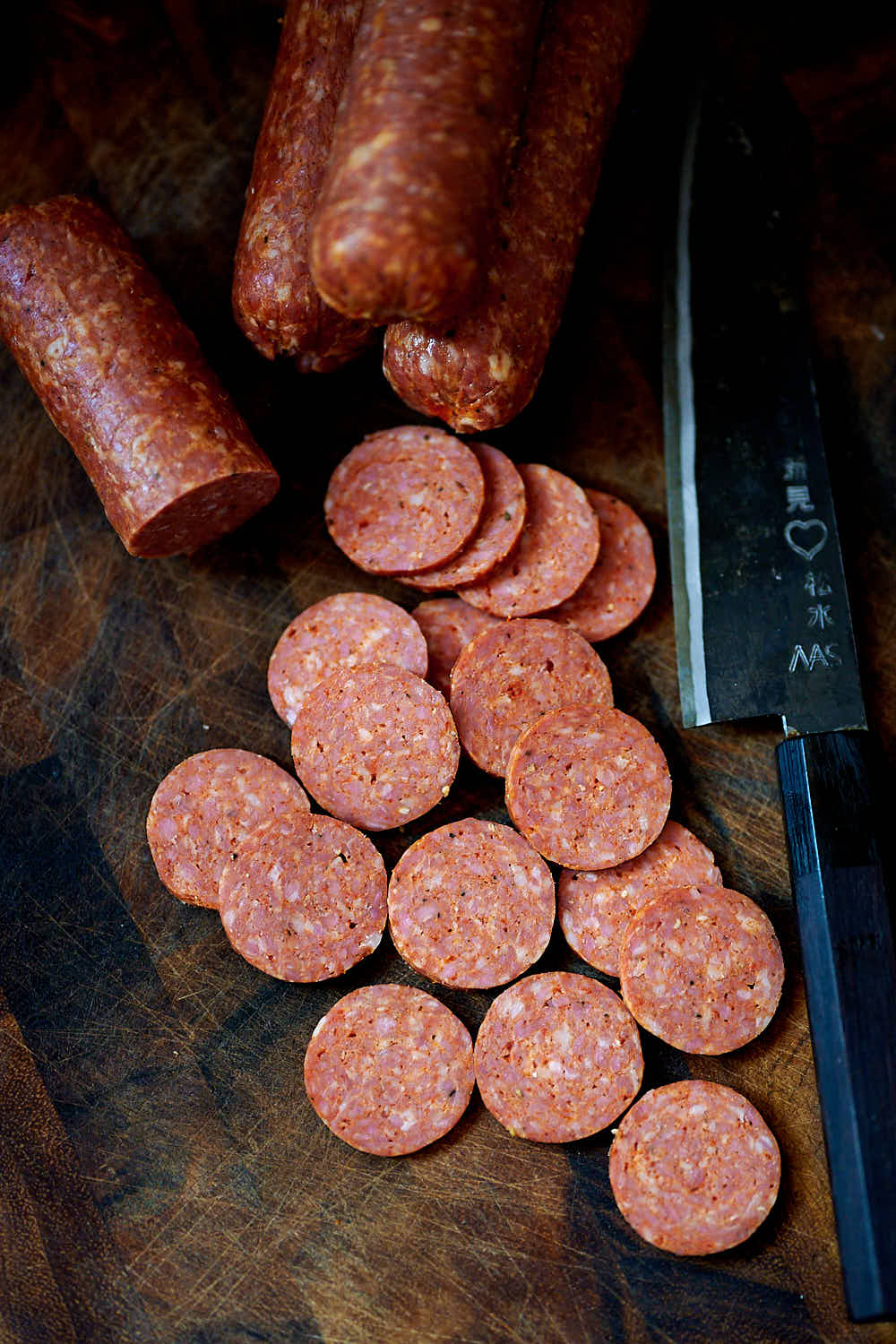
Making pepperoni sausage at home is extremely rewarding and is very similar to the making of Summer sausage. I made it once many years ago and it has become a staple at our home. This is not your typical store-bought pepperoni - this one has better texture, much better flavor, and it tastes like high quality sausage. This sausage is outstanding. You can even make sandwiches with it, it's that good. Smoked pepperoni is to die for. Your pizzas will taste better than ever. Smoke greatly improves flavor and increases shelf life of sausage due to its antibacterial properties. In this article I will talk about how to make pepperoni sausage at home and share my experience.
What is pepperoni sausage?
Pepperoni sausage is an Italian-American semi-dry fermented sausage typically made of pork and beef. Pepperoni sausage made of beef or pork alone is also common. Peperoni is seasoned with paprika and aromatic herbs, has a soft texture, is slightly smoky, and bright red in color. It is a popular pizza topping in American pizzerias.
The name pepperoni implies Italian origin but it's far from the truth. It does have some similarities to the spicy salamis of southern Italy, such as salsiccia Napoletana piccante, or Calabrese salami. Pepperoni has a finer grain though, is usually softer, and is made with artificial casings.
The meat
Pepperoni sausage is typically made of a combination of pork and beef, or pork or beef alone. The ratios of pork to beef vary from 75% pork and 25% beef to 25% pork and 75% beef. It really depends on personal preference. Sometimes all you have is pork butt, or chuck roast, and may decide to make an all pork or all beef pepperoni. My personal preference for pepperoni is 75% to 100% pork.
The taste of pepperoni sausage is very much dependent on the freshness and the quality of meat. To get the best results, buy your meat fresh and grind it yourself. Alternatively, ask your butcher to grind it for you. You want to grind the meat fairly fine, through a 3/16" (4.5mm) plate.
Pepperoni sausage spices
The dominating spice in this sausage is paprika, which gives it a characteristic orange color. You will also find aromatic spices such as anise, allspice, fennel, nutmeg, cinnamon, cloves, mustard and black pepper among the commonly used spices in pepperoni sausage. Many recipes also add cayenne pepper for a little kick.
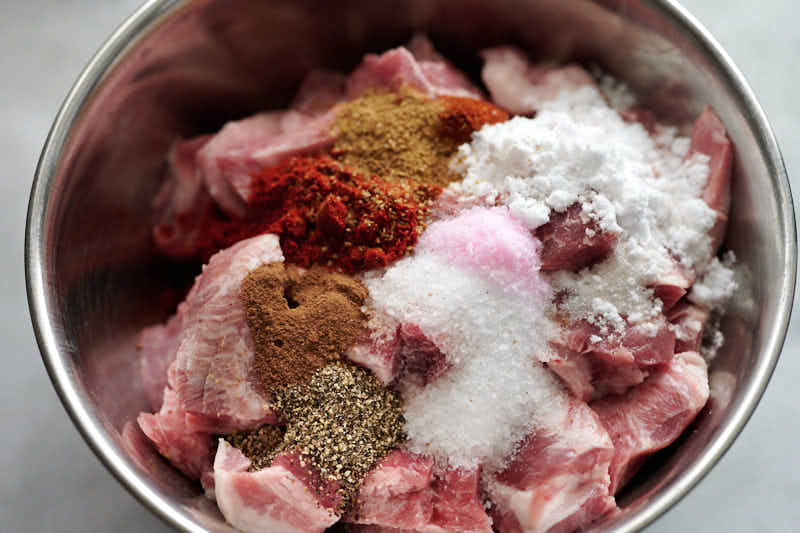
The best pepperoni sausage though is the sausage made to suit your taste, so feel free to experiment to come up with your favorite spice combination. If possible, grind your spices just before adding them to the ground meat. This will help you get the most flavor out of them.
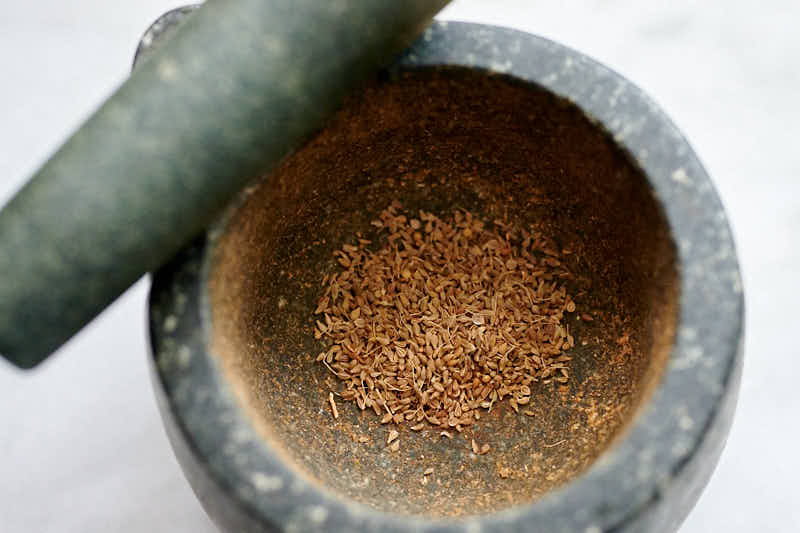
Curing salt and cultures
As the typical pepperoni sausage is a fermented semi-dry sausage, a meat culture such as Bactoferm FL-C is used. Bactoferm F-LC meat culture with bioprotective properties is used for the production of fermented sausages with short or traditional production times. During fermentation pH of the meat drops to 5.3 which helps inhibit growth of pathogenic bacteria and gives the sausage its tangy taste. FL-C culture can be purchased from sausagemaker.com or butcher-packer.com.
In this recipe, pepperoni sausage is fermented and then smoked at temperatures that promote growth of unwanted bacteria. To prevent that, Cure #1 (also known as pink salt) is used. Pink salt also improves flavor, prevents food poisoning, tenderizes meat, and develops the pink color widely known and associated with smoked meats. You can purchase Cure #1 from the online stores mentioned above as well as on Amazon - DQ Curing Salt #1 / Pink Salt.
Grinding meat and mixing with spices
You want to make sure that the salt and the spices are mixed well with the meat and distributed evenly. One way to ensure even seasoning distribution is to mix them with the pieces of meat before they are ground. This is my favorite method and it works very well.
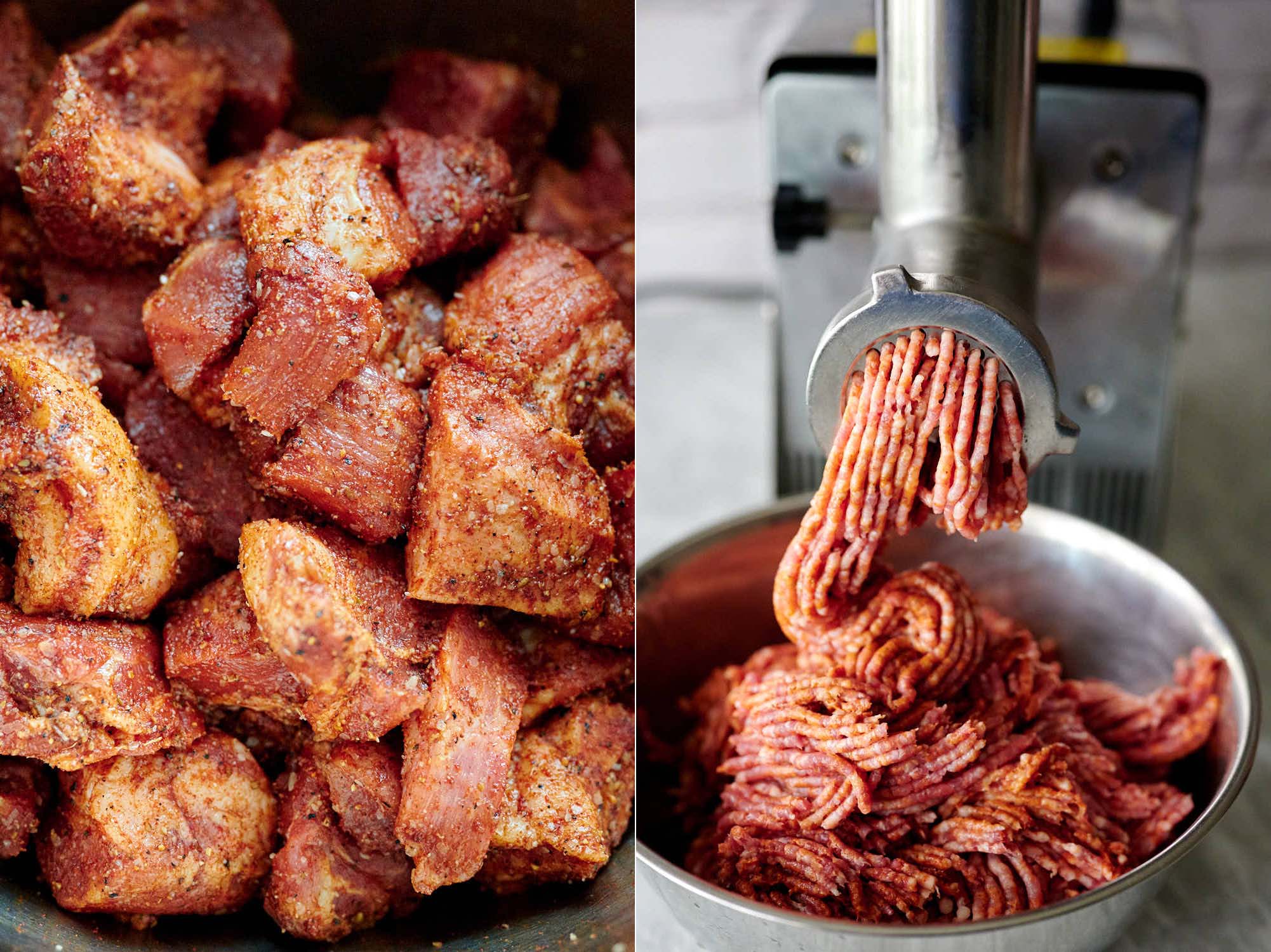
After grinding the meat, simply add the starter culture re-hydrated in 1/3 cup of water and mix well.
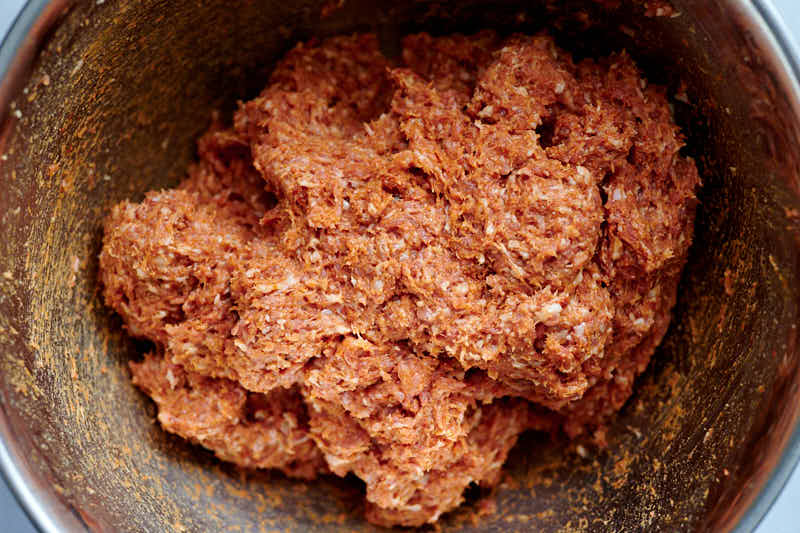
Sausage casings
The most common casing size used for pepperoni sausage is 1 1/2" (38mm) in diameter. This is the size that most pepperoni produced in America uses.
That said, there is nothing wrong with making pepperoni a bit thicker, like 2" - 2 1/2" (50-60mm). You can use beef middles or collagen casings. I like to use collagen casings for pepperoni sausage as they are easier to use and make straight links. These casings are sold as pepperoni stick casings and can be purchased from a variety of places, e.g. your local sausage making supply store, Amazon (Non-Edible Fibrous Casings), thesausagemaker.com, or butcher-packer.com.
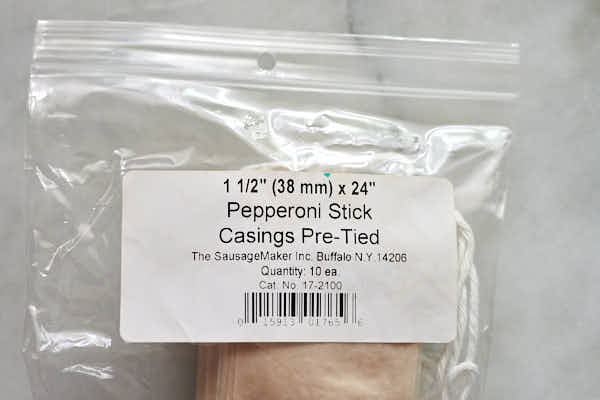
Stuffing meat into casings
The most efficient and economical way to stuff the meat into casings is to use a vertical sausage stuffer, such as the LEM Products 5 Pound Sausage Stuffer or the LEM Motorized 20 lb stuffer. I own both of these stuffers, they both do a great job, though one is perfect for one-person operation.
You may also use a sausage stuffer attachment for your meat grinder, but you may be disappointed with the results. Meat grinders are not designed for stuffing sausages and, frankly, do a very poor job at it.
A cheaper alternative to a vertical sausage stuffer that would yield better results than a meat grinder attachment would be a manual sausage stuffer like the LEM Manual Sausage Stuffer. These stuffers are great for occasional use. They are hard to use and require good physical strength to operate, but can produce good results after some practice.
Stuff the meat firmly, ensuring that no air pockets remain inside. Getting all the air out is practically impossible and you will see some tiny cavities after your sausage is done. This is not a problem for semi-dry sausages. Just do your best but don't worry if some tiny air pockets remain.
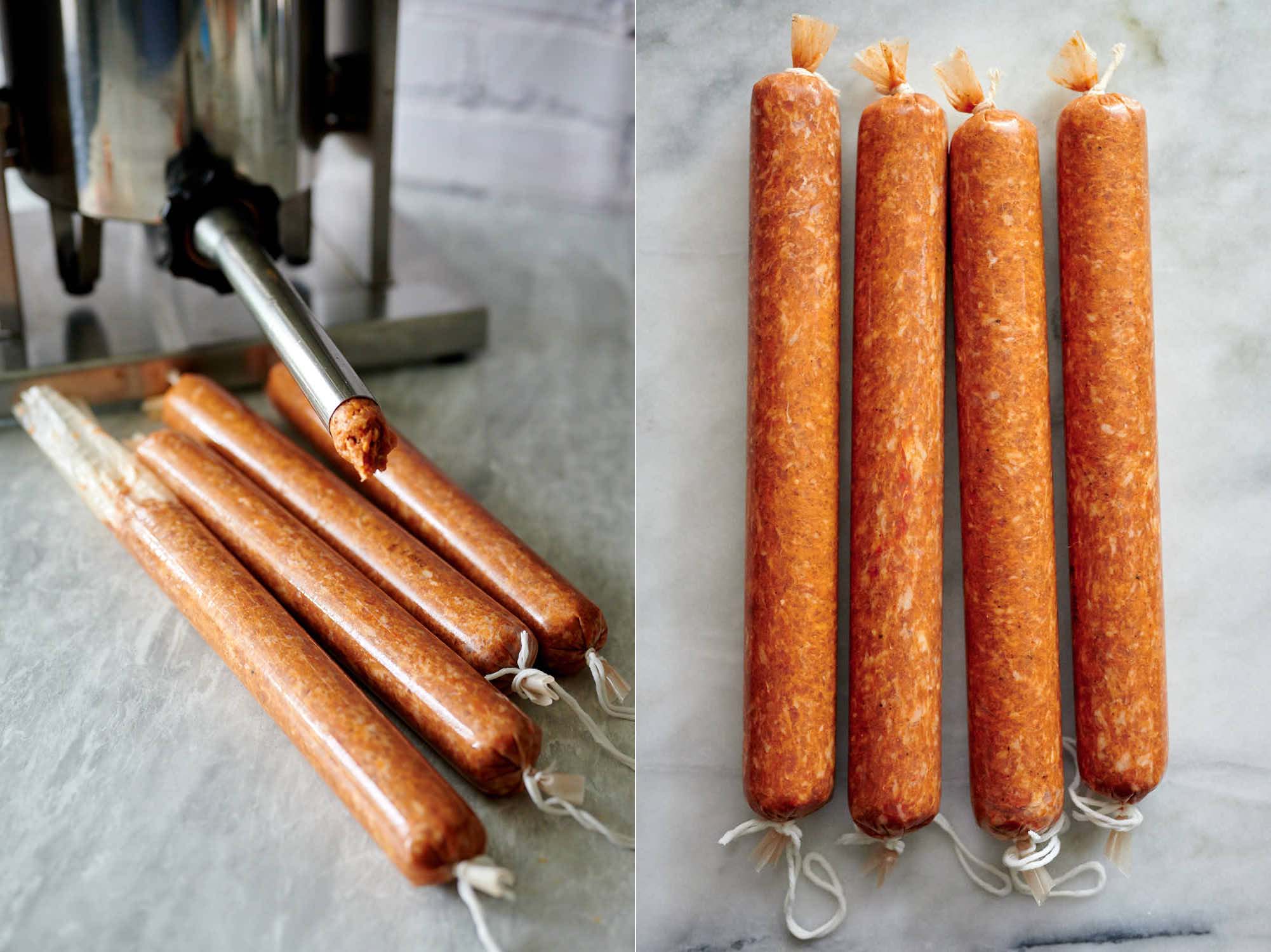
The cooking equipment
To smoke pepperoni sausage, you will need a smoker or a grill that is capable of maintaining low temperatures.
Electric smokers
A dedicated electric sausage smoker would be ideal, like the very popular Masterbuilt 30-Inch Smoker. Many people consider this smoker to be the best value for home sausage making needs.
Should you need a looking window to enjoy your sausage while it's being smoked, you can get an equally popular Masterbuilt 30-Inch Electric Smoker with Window and RF Controller.
Using a propane smoker
If you like propane-fuelled smokers, the Masterbuilt XL propane smoker is a very good choice. I used one for years to make my favorite Polish kielbasa and many other smoked sausages.

It's not that easy to maintain low temperatures with, but modifying it with a needle valve, like the Bayou Classic Brass Control Valve, will fix that. If you don't feel comfortable installing a needle valve into the gas line yourself, you can buy a pre-made gas assembly, like the Bayou Classic M5HPR-1 10 PSI Hose, Regulator, Valve Assembly
. You need to make sure that the regulator on the assembly you are buying matches the specs of your burner. Needle Valves for Gassers is a good resource for more information on this.
Using a smokehouse
This is the ultimate option. If you want a taste of traditional smoked sausage, smoke in a smokehouse. I don't know what it is, the air flow, the humidity or something else, but sausages smoked in a smokehouse feel and taste a little different. I recently built a smokehouse and use it for smoking sausage. If you are a DIY type, check out Stanley Marianski's excellent book called Meat Smoking And Smokehouse Design that talks about different smoker designs that you can build at home.
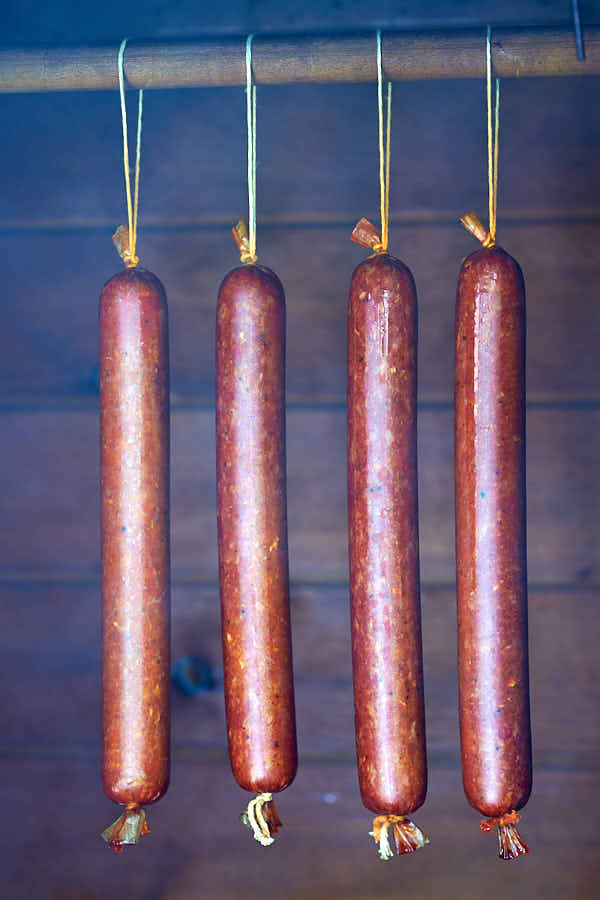
Other smoking equipment
If you have a Big Green Egg, it's a viable option as well. I've used it for smoking sausages, like summer sausage, at low heat before building my smokehouse. It's not too hard to start this grill at about 110F and maintain that temperature for about 1-2 hours. Eventually, the temperature will creep up but that's exactly what you want anyway. You just have to control the airflow such that the temperature does not rise too quickly.
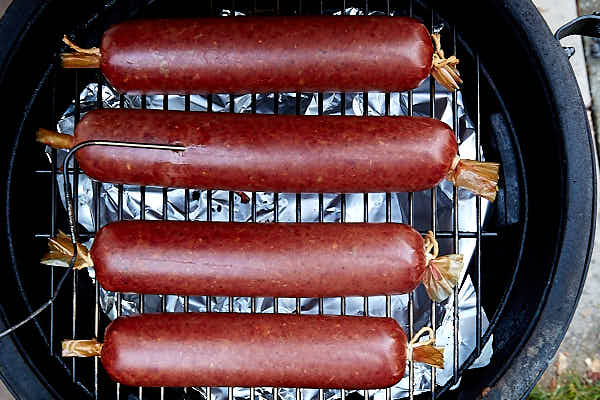
The final resort option
If none of the above works for you, don't give up. You can cook your sausage in the kitchen oven. You won't get the same amazing smoky flavor and the color, but it's still better than nothing. Just make sure to cook the sausage at low temperatures to not let the fat melt out. This is very important.
Cooking temperature
Stanley Marianski in his Home Production of Quality Meats and Sausages book mentions that once the temperature of the meat reaches about 100F all fat tissues become liquid. That said, there is very little fat loss between 150 - 190F or even up to the boiling point of water of 212F. Above those levels, the fat starts to leak out quite rapidly. There is a significant fat loss at temperatures over 248F. Sausages cooked at temperatures higher than 190F will have a dry, crumbly texture.
Ideally, smoke your pepperoni at 110F – 130F until the desired color is achieved, then gradually increase the temperature to 150-175F, and then all the way to 190F if needed, to achieve the internal temperature of 140F.
If cooking in the oven, start cooking the sausage at the lowest setting (usually around 170F) and slowly increase to 190F, until the internal temperature of the sausage reaches the target temperature.

Ingredients
- 700 g pork butt about 1.54 lbs; see notes
- 300 g beef chuck about 0.66 lbs; see notes
- 23 g salt about 4 tsp
- 2.5 g Cure #1 about 1/2 tsp
- 10 g dextrose or glucose; about 2 tsp
- 5 g sugar - 5.0 g about 1 tsp
- 3 g black pepper ground, about 1½ tsp
- 8 g sweet paprika ground, about 4 tsp
- 2.5 g anise seeds ground; about 1 tsp
- 2 g allspice ground; about 1 tsp
- 2 g cayenne pepper about 1 tsp
- 0.24 g F-LC culture use scale
- 80 ml distilled water about 1/3 cup
Instructions
- Grind pork and beef through 3/16” plate (5 mm).
- Mix all ingredients with ground meat.
- Stuff into beef middles or fibrous casings about 60 mm in diameter.
- Ferment at 86F (30C) and 85-90% humidity for 24 hours.
- Place the sausage in the smoker and smoke at 110F - 130F and 70% humidity for 6 hours. Gradually increase smoke temperature to 150-175F, and then all the way to 190F if needed, until internal meat temperature reaches 140F.
- For a drier sausage, dry for 3 days at 60-70F and 65-75% humidity or until desired weight loss is achieved.
- Store sausages at 50-59F and 75-80% humidity.
Notes
Nutrition
Recipe variations
If you want to use a different process, without fermentation, I suggest Rytek Kutases recipe which suggests using 2 Tbsp powdered dextrose, 3/4 cup fermento and 3 Tbsp corn syrup solids per 10 lbs of meat. Cook sausages to 152F internal in this case.
If you don't have the starter culture, or Fermento, but really want to make pepperoni, you can always make it as you would a regular kielbasa. Follow my Polish kielbasa recipe process, only replace the spices and seasonings with the ones in this recipe. The sausage won't be exactly like pepperoni but will be pretty close and will taste great nevertheless.


Jason says
What’s the best way to ascertain the 140 temp? I have probes but seems like if you penetrate the casing it will then allow fat to exit? Laser gun?
Victor @ Taste of Artisan says
Jason, a laser gun won't work. If you want to be precise, you have to get in with a probe. Keep in mind that the higher the temp in the smoker, the faster the fat will melt and exit through the hole. So, don't get the temp too high.
Dave in Cebu says
I live in the Philippines and am unable to find any starter cultures for sausages or encapsulated citric acid. I do a fair amount of fermentation (hot sauce, full sour pickles, and sauerkraut) and was wondering if leftover brine could be used. Google AI says brine or yogurt can be used to ferment meats but don't say how to use them. Also, I really don't trust Google AI as I have seen it give wrong information.
Victor @ Taste of Artisan says
Hi Dave. That's a very good question. I have no idea as I've never experimented with those products as starter cultures. I have two concerns - one is will they work effectively in providing a proper acidification of meat to reach 5.3 to inhibit growth of pathogenic bacteria. If I were trying to use those, I'd make sure to have a good pH meter to monitor pH. The other concern is the flavor. Will using any of those natural pro-biotic cultures provide a good flavor? This needs to be tested and one would then make a determination.
I would also refer you to this thread - https://en.wedlinydomowe.pl/viewtopic.php?t=6588 - it has a very good discussion on this topic, I think you will find it helpful.
Good luck!
John Cunningham says
Eric at 2 Guys and a Cooler YouTube makes Mexican Salami fermented using sauerkraut juice as a starter. His result seemed pretty good.
Alice says
You have no idea how grateful I am for this recipe! I've wanted to taste more pepperoni over the years but I just don't have access to it. So this recipe is a lifesaver and that's because I can find all the listed spices in the recipe easily! Thank you so much for posting this recipe.
Victor @ Taste of Artisan says
You are very welcome, Alice. Enjoy!
Erin says
Really good.
Victor @ Taste of Artisan says
Glad to hear it. Enjoy!
Bruce Damen says
After smoking have you ever have tried Sous vide to cool sausage to temp? Curious. Want to try doing it when I try out the pepperoni recipe
Victor @ Taste of Artisan says
To cool? Or did you mean to cook? I don't use my sous vide but I've poaching sausage after smoking and find it very helpful. I described this method in my Polish Kielbasa recipe and others. Sure, you can use the sous vide for that as well.
Bill A says
This is a great recipe. Easy to follow and produces a nice tasting sausage. Just mix it all together, fill em up, ferment overnight and smoke to 140f. You can’t mess it up. Also you can customize to your tastes easily. Thanks for the great recipe.
Victor @ Taste of Artisan says
You are very welcome. Enjoy!
Gary l Nuss says
Victor, I do not have any kind of curing chamber for this recipe using the Bactiferm. I would still like to try using the Bactiferm. What methods could I use for this recipe as far as heat and moisture?
Victor @ Taste of Artisan says
It's a good idea as it will give the sausage a nice tang and balance the taste. You don't really need a curing/fermentation chamber for this sausage. Any smaller, closed space will do. The sausage itself, while at this stage, will be releasing liquid and keeping humidity way up, but it needs to be in a closed space. A large cooler will do great. A small room will be a bit of a problem to keep the humidity up in as it's not insulated, usually. As far as heat, I use small, 10x20 seedling heating mats. I now use them in my curing chambers but I used to in coolers. They work great. You need a controller to maintain the temp, like Inkbird temp controller.
If you don't have a large cooler, you can get creative. I have a large crawfish pot, I'd use it in a pinch. But wrap it with towels to insulate. Worse comes to worse, ferment in your oven. Oven light on will give you some warmth. Make sure to close the vents to keep the heat in. You can fill a gallon milk container with warm water and put in the oven, and it will provide enough warmth for good fermentation. Lots of way to do it. Just remember, a closed space, insulated, to keep humidity high, and about 86F-90F temperature. Time to get resourcefull. Good luck! Let me know how it turns out.
Mike says
Well I'm really committing to this recipe it sounds amazing.y question is if I'm making a 9kg batch do I multiply the water by 9? 720ml sounds like a lot of water
Thanks!
Victor @ Taste of Artisan says
Mike, I always advise to keep water at the same level until you go 3x the recipe, that's when you double the water, then 3x water once you go 6x the recipe, and so on. This works for me. But also, just feel the meat. If it feels too stiff, add more. You want to be able to distribute the seasonigns and stuff the meat easily. As long as you can do that, you don't need more water. I don't like watery sausage and actually dry my smoked sausages in the curing chamber (or garage/cold room during colder months) for a week after smoking, so I try to add as little water as I reasonbaly can. Good luck!
RICHARD JENKINS says
how long can it be stored at 50 to 59 degrees
Victor @ Taste of Artisan says
It's an interesting question. I could say indefinitely but there is a limit. The sausage will be drying until the rate of diffusion (mositure coming up to the surface from inside) equal rate of evaporation, i.e. moisture leaving the surface of the sausage, which is determined buy the humidity inside the curing chamber. But in reality, the humidty will fluctuate and the sausage may get drier or it may get wetter and moldy if the humidity is too high. So you wouldn't want to keep it there fot too long if that's the case. I've had sausage hang in my curing chamber for months and it was great, the trick is to keep the humidity at the right level all the time. As the sausage gets drier, it becomes more challenging in the curing chamber. Once it gets dry enough, it will not spoil. Or you can get it dry enough and then vacuum seal and refrigerate or freeze. In the fridge, it will keep for months. Even longer in the freezer.
John Cunningham says
Victor, thanks for the recipe. Used pork shoulder only and it is the best pepperoni I've made to date. Reduced the dextrose to 8g/Kg and sugar to 3g/Kg as I wanted a bit milder "tang". pH after 30 hour fermentation at 86F was 4.98, perfect for me. Stuffed in 35-38mm hog casing, smoked at 120F for 2 hours, sous vide at 145º for 2 hours, and dried at 60º / 70-75% to weight loss 30%. Delicious . . . . thanks again.
Victor @ Taste of Artisan says
Hi John, you are very welcome, and thank you for the feedback. You must try my Andouille sausage, it's fantastic. All of the ones that I posted are really good 😉
Jim House says
I had ordered some Soy Protein powder from The Sausage Maker . I also have some Whey powder at home . Are either of those a substitute . Where is dehydrated buttermilk found ?
Victor @ Taste of Artisan says
Those are different things. I get my buttermilk powder on Amazon.
Jim House says
I was going to try your pepperoni this week end until I got to the FLC culture . What is it and is it required . I assume that it is or it wouldn’t be in the recipe . Since I do not have any how will the taste be different . JIM
Victor @ Taste of Artisan says
Well, there are many ways to make any sausage, so this is one way to make pepperoni. In my opinion, this methods produces a better tasting pepperoni. FL-C is a bacterial culture that introduces lactic acid bacteria into meat to quickly acidify it. This, among other things like protection against the growth of harmful bacteria, makes the sausage taste pleasantly tangy. However, you can certainly skip the culture, along with sugar and dextrose, and the whole feremntation step. Instead, you can use Fermento (sold by the sausagemaker.com) or simply dehydrated buttermilk, which is what Fermento is. I use about half a cup to full cup of powdered buttermilk per 5 lbs of meat, depending on how tangy I want it. Hope this helps. Good luck.
Gary l Nuss says
So, in this method with the Fermento, is the dextrose and sugar eliminated from your recipe? And when using the Fermento, is it mixed in with the meat/spices and directly to the smoker or can the stuffed sausages sit in the refrigerator overnight?
Victor @ Taste of Artisan says
Correct, you don't need sucrose and/or dextrose when using Fermento or powdered buttermilk (which is what I use now, and which is basically the same as Fermento). You can mix and stuff ahead and smoke the following day, that's not going to be a problem. Good luck!
jackie says
I just learned I'm allergic to onions and garlic. That lets out grocery store pepperoni and sausage.
As a great cook, I'll be using your recipe from now on. It sounds delicious besides. Thanks so much.
Victor @ Taste of Artisan says
Enjoy!
Mike Young says
I read that you suggest beef or collagen casings. I an completely new to this. Would pork casings work?
Victor @ Taste of Artisan says
Mike, welcome to the hobby. If you want your sausage to have a certain look, like the store-bought pepperoni, you can use 1 1/2" inch collagen or fibrous casings. These are easier to use, very little prep is required. That said, if you don't care about a particular look/style, you can use any casing you want, from thin sheep casings which will give you pepperoni sticks to very large/thick casings. Same taste/flavor just a different look and different cooking times as thinner sausages will cook faster and vice versa. Standard hog casings will work fine.
Ramona Smith says
I made a vegan version using your seasonings. It was fantastic. Thank you for a great recipe!!
Victor @ Taste of Artisan says
You are very welcome, enjoy!
Frank W. says
Hello Again Victor!
I'm now into my 3rd batch of this pepperoni recipe.
Batch 1: Good \ fair, found my shortcomings and it didn't last long. (12lbs gone in a week between me, wife, dogs, in-laws, grand-kids and neighbors.)
Batch 2: I felt it needed more pepper and a touch of garlic. Wish I'd left well enough alone. What was I thinking? Perfection is not to be altered.
Batch 3: Back to your original recipe and I finally figured out how to keep a low temp in my upright smoker. A baffle (sheet steel with a gazillion holes punched in it) in the bottom where the water bowl goes helped eliminate hot spots (thanks for the idea).
Last, I found after 5 - 6 hrs in the smoker at 130 - 135 deg then into the oven for 1 hr at 175 deg and they come out PERFECT. No fat melt and oil drip.
I can't say enough about this recipe. Well done, my friend.
Sorry, no pics this time. Most of it's gone already anyway.
Victor @ Taste of Artisan says
Hi Frank, good to hear from you and I am happy to read about your success. One hour at 175F, ha? I tried baking in my old cheapo electric oven but it did not quite work well. I can't recall the numbers but I think I had to bump the temp up to 200F and it took close to an hour too but the skin came out pretty dry. I will try in my new gas oven out of curiosity. I am also experimenting with increasing humidity in my smokehouse during the 'baking' stage and so far it looks promising. I used a bowl of hot water but that was not quite sufficient so I am thinking of injecting humidity using an ultrasonic humidifier or feed hot steam if need be. Shouldn't be too hard. Commercial sausage makers have no problem finishing in their smokehouses at 175F or so fairly quickly but I strongly suspect they achieve that with pretty high humidity, there is no other way. Poaching works very well too, very quick, predictable and results in very soft skin though some color and smokiness are lost. Anyway, enjoy the sausage, I love this sone. I will be posting a few more of my favorite sausage recipes soon, try them.
Brett says
Hello Victor -
I made up a batch of your Kabanos yesterday, they're in the fridge drying out a bit, but I snuck a taste this morning and they are everything you said they'd be! Delicious.
I also made a batch of pepperoni, but like someone else I stuffed them into 22mm casings for snacking. After 24 hours in the oven fermenting, I smoked for an hour and then was going to finish in hot water like I did the Kabanos. But ended up with water getting between the casing and the meat. I'm not sure if they would have been salvageable or not, but I didn't want to risk it so tossed 2/3 of a 10 pound batch. The rest I'll finish either in the smoker or oven. Any ideas what might have happened?
Victor @ Taste of Artisan says
Hi Brett, glad to hear that you like the kabanos. You should try my chicken sausage, it's a hit this year.
Sorry to hear about your pepperoni. It would have been 100% salvageable. Just squeeze out as much water as you can, dry it and it will be fine. Skin separating from the meat usually happens to me when I smoke at too high temps, the fat melts out leaving pockets of air that water happily would fill out. It also happened to me when using collagen casings that don't shrink at the same rate as the meat. I've also seen this when making leaner sausage, or poorly mixed sausage with low levels of myoglobin.
So, the solution is to use enough fat, mix really well, until the mass is sticky enough, smoke at low temps, use natural casings if possible. Now, that said, I am sure you can easily use any casing and smoke on a regular BBQ at high temps and you will still be fine. Just vacuum seal those suckers, or put in Ziploc bags trying to get as much air out as possible, and poaching in bags. Same effect but no water will get in. Will be smokier too, though the skin won't be as soft as poaching in water directly.
When finishing in the oven, add a pan with boiling water to keep humidity up. It will prevent the skin from drying out and will help cook the sausage faster. That's my most recent tweak. I do it when finishing in the smokehouse too. Good luck.
Brett says
Thank you for all of your help and suggestions. I will definitely give it a try again with all of those in mind. I used about 2/3 fatty pork shoulder and 1/3 venison, and the smoker was at 120-130. So I’m guessing maybe I didn’t mix the meat and spices long enough to get it tacky. Will enjoy my Kabanos and give the pepperoni another try!
Victor @ Taste of Artisan says
You are very welcome and good luck. Hope it turns out much better next time.
Kevin Schneider says
What is the recommended wood type for smoking the pepperoni sausage?
Victor @ Taste of Artisan says
That's a good question. Traditionally, Italian pepperoni is not smoked so there is no specific wood type for this type of sausage. Now, personally, I like cherry wood for that gives the sausage dark red color and sweet flavor. Pecan and hickory are very good too. Oak is another good option.
Jo says
What is the shelf life like on these if vacuum sealed? I see from other comments you can freeze them, which is a good option but fresh is best 🙂
Victor @ Taste of Artisan says
Jo, this is a good question. It depends. I don't have a scientific answer and will only go by my experience. Smoked, chilled and vacuum sealed it should be good for at least a month and more. This sausage will still have plenty of water in it so the shelf life will be somewhat limited. If you dry it for a week or two after smoking, vacuum seal, it will last many months, 3-6 months+. If you don't have a curing/drying chamber, dry in a refrigerator. IN a fridge, wrapped in plain butcher's paper it will dry within a few weeks. Once it's dry enough to your liking, vacuum seal to stop further drying. This one will store much, much longer. 6 months+ easily or longer depending on how dry it is. I've had sausages that I forgot about sitting the fridge for over a year that were perfectly fine, not vacuum sealed. They got a little too dry but smelled and tasted great.
Devin says
For those that have to resort to the oven method but still want smokey flavor, I might advise one of the small cold smoking tubes available online.
It's about $20, you fill it with wood pellets and then torch the end and allow it to burn for about ten minutes before blowing the flame out.
You then get several hours of strong smoke with little to no heat.
I use one of these for cold smoking cheeses, and I would imagine that anyone that has no smoking equipment could let their sausage be cold smoked like this for a while before putting it in the oven
John says
Great recipe, tried it by substituting sugar for the dextrose. It was good but from that I have researched the dextrose acts as a binder as well as food for the culture. It turned out great.
Since I made the first batch I have ordered dextrose but it won't be in with enough time to make a batch so with more research one similar recipe calls for powered milk to be used as a binder accompanied with corn syrup.
What are your thoughts on this?
Victor @ Taste of Artisan says
Hi John, sorry for the long delay in responding to your comment. To be honest, I've never used powdered milk in my sausages so I can't comment on that. No particular reason why. I have used powdered buttermilk in my fresh chicken sausage to give it some tang, not to change the texture, the results are really good. I may experiment more with those ingredients in the near future.
Mike Raether says
Just finished a batch of your pepperoni and it is wonderful! Thank you. Used 2/3 pork butt and 1/3 venison. Seasoning was just right for me. Smoked with hickory chips. Stuffed into 19mm edible collagen casings as I wanted as snacking sticks. I had my wife pick up a ham shank portion so I can try your Kielbasa recipe next. Or maybe I’ll try the brats . . . Or maybe . . .
I’m like the proverbial kid in a candy store!
Victor @ Taste of Artisan says
Hi Mike, your comment put a smile on my face;) Happy to see that you enjoy reading my blog and the recipes here. For snacking, try the kabanos recipe. My family loves it. I've also been playing with a chicken sausage recipe and after several batches I think it's outstanding. The only problem is that when I make say 10lbs it's gone in just a few days. Hard to resist. I will post the recipe on the blog when I get a chance.
Leigh Smith says
You can use a couple table spoons of sauerkraut juice (contains lactobacillus) and ferment as described.
Victor @ Taste of Artisan says
Very true, but who knows what's in that juice. Meaning it can be contaminated with spoilage bacteria, bacteria population may be too low, etc. Also, it's very hard to find proper (fermented) sauerkraut nowadays. A lot of store-bought sauerkraut is nothing but flavored pickled cabbage so have to be careful about that. Using a culture is a sure and predictable way IMHO.
Raymond Campbell says
Victor,your pepperoni looks wrinkle free,did you give it an ice bath,or just hanged it at room temp?
Victor @ Taste of Artisan says
Hi Raymond, sorry for the delayed response, yes, I gave them a bath to cool down. That sure helps keep them nice and plump. You can also smoke at low temp then poach in a hot water batch to bring the internal temperature up. I use that method often, it makes thing much easier and faster and keeps the wrinkles away.
Matt says
I see a lot of recipes that call for red wine. Could red wine substitute the water in this recipe?
Thanks!
Matt
Victor @ Taste of Artisan says
You'd need some water to activate the starter culture but it won't hurt if you add some wine on top. For larger batches it's easier - say if you are starting with 3 kg of meat, you can use 80 ml of water for the starter culture and add 160 ml of wine, or even more...
Matt says
Sounds like a plan. Thanks!!
Abi says
I just followed your recipe for pepperoni in the oven. How do I store it? Can it be hung in a cool, dry place or does it need refrigeration/freezing?
Thanks so much!
Victor @ Taste of Artisan says
Step #7 in instructions:
Store sausages at 50-59F and 75-80% humidity.
This way it will be drying slowly and the shelf life will extend. In general, simply refrigerate. To store without refrigeration you'd need to prepare it a bit differently.
Matt Cosgrove says
After a few days in the fridge, can it be frozen?
Thanks!
Matt
Victor @ Taste of Artisan says
I've frozen dry and semi-dry sausage before... it's fine... I think the texture changes a little but still good. Make sure to defrost in a fridge though.
Ray says
one word outstanding,followed the recipe to the letter,best I have made
Victor @ Taste of Artisan says
Glad to hear it, Ray. Now try my other recipes;) Plenty of good ones. Enjoy!
Darlene says
Hi, for the oven method- is the target internal temperature 190F? Noting gradual temp increase from 170-190F- just not clear if that is the target internal temperature as well.
Victor @ Taste of Artisan says
Darlene, the target internal temp of the pepperoni is 140F.
MICHAEL says
I think there might be some confusion because above the recipe you have "deally, smoke your pepperoni at 110F – 130F until the desired color is achieved, then gradually increase the temperature to 150-175F and then all the way to 190F." under cooking temperature
Victor @ Taste of Artisan says
Hi Michael, I am not sure where I caused confusion, perhaps me being more concise in the instructions. I updated it.
Paula says
Can I use honey or sugar in place of the dextrose? In what ratio, if so?
Victor @ Taste of Artisan says
Sugar will do just fine, I've substituted dextrose for sugar without any obvious effects.
Lee says
Hi, I'm not new to making salami but this is the first time making pepperoni. Using 65mm casings and smoking them in the pizza over 6 hrs turned out brilliant. Have ended up with nearly 3kg for $30 ish (AUS).
Thanks for the recipe.
Victor @ Taste of Artisan says
Glad to hear that, Lee. You are very welcome.
Ginger says
Instead of an oven, would a dehydrator work to dry the pepperoni?
Victor @ Taste of Artisan says
You need to cook it 140F internal first then dry. I suppose a dehydrator might work but I haven't tried myself.
William says
First off, great website - thanks you for sharing the information - very inspiring!!!!!
I am assembling all of the equipment and materials for my 1st shot at homemade pepperoni. In your instructions for making pepperoni you state "Ferment at 86F (30C) and 85-90% humidity for 24 hours"
How do you achieve and monitor this step?
Victor @ Taste of Artisan says
Hi William, welcome to my blog and to this exciting hobby. I am sure you will love it.
As for how these fermentation conditions can be achieved - there are a few options. One is a curing chamber. I use mine for both fermentation and maturing salumi. Now, this is not a trivial solution and, frankly, not needed unless you want to immerse yourself into the beautifully tasty world of salumi making.
The simplest and cheapest option is a good old oven. Turn the light on, shut the door, close the vents, and you will have a perfect 80F-90F temperature, depending on your oven, and the humidity will be around 90F because of the moisture released by the sausage itself. Super simple and works like a charm. I also use the oven with the light on to ferment dough.
For monitoring, you can get a hygrometer with a probe like the Extech here which I own and like for certain uses, or the Inkbird hygrometer with a data logger paired with a smartphone. But honestly, I checked the temperature once or twice in my oven and it was about 85F and ever since then I've never checked again. I don't worry about humidity when fermenting this type of sausage, it will be perfectly fine for making this type of sausage, even with some deviation. Humidity is far more critical when making dry-cured meats and sausages.
William says
Thanks for the great advice!!!!
Philip S says
I love your website. I have made several of your sausage recipes and they all turned out great. My family loves homemade sausage and I can’t make enough. With three boys in the house it’s gone in no time. I just made the pepperoni and summer sausage but used encapsulated citric acid and the results were perfect. My wife is big into baking so she is going to try your sour dough cinnamon buns soon. Can’t wait to try them
Victor @ Taste of Artisan says
Good to hear it Philip. Thank you for the compliment. Try my kabanos sausage - my kids love it the most. I sometimes stuff it in regular hog casings still outstanding.
James K says
Outstanding! Followed the recipe exactly and smoked on my BGE at about 175F as I couldn't keep the temperature lower. The pepperoni sausage still turned out excellent.
Laiba S says
i love pizza so much😘
do you know i never eat pizza but i like it
Laiba S says
I love your website. I have made several of your sausage recipes and they all turned out great. My family loves homemade sausage and I can’t make enough. With three boys in the house it’s gone in no time. I just made the pepperoni and summer sausage but used encapsulated citric acid and the results were perfect. My wife is big into baking so she is going to try your sour dough cinnamon buns soon. Can’t wait to try them
Victor @ Taste of Artisan says
Happy to hear it. Enjoy!
Victor @ Taste of Artisan says
Hard not to like artisanal pizza. It's delicious.
Laiba S says
🍕i love pizza is my favorite